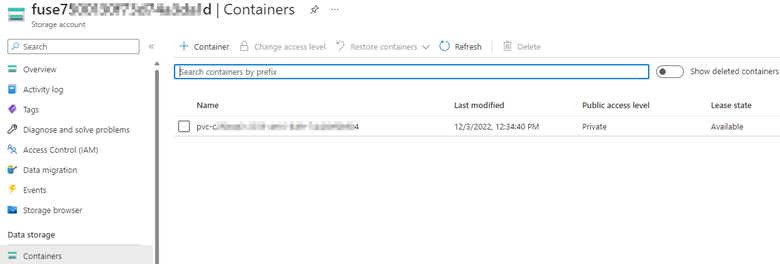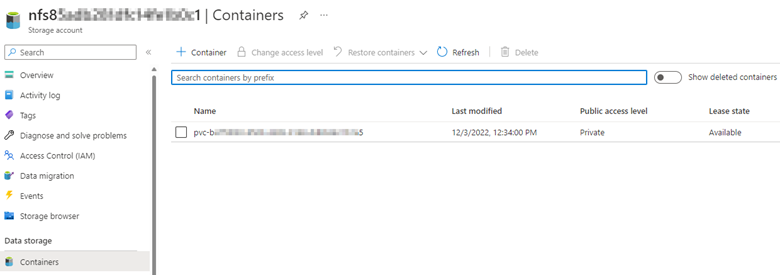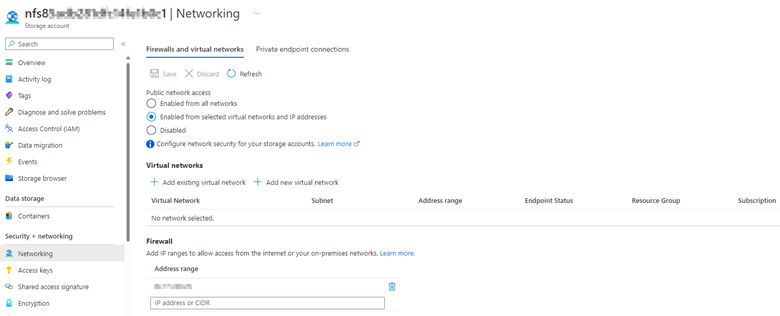Errors when mounting an Azure Blob storage container
This article provides possible causes and solutions for errors that cause the mounting of an Azure Blob storage container to fail.
Symptoms
In an Azure Kubernetes Service (AKS) environment, you deploy a Kubernetes resource such as a Deployment and a StatefulSet. The deployment will create a pod that mounts a PersistentVolumeClaim (PVC) referencing an Azure Blob storage container.
However, the pod stays in the ContainerCreating status. When you run the kubectl describe pods command, you may see one of the following errors in the command output, which causes the mounting operation to fail.
Note
Azure Blob storage container may use the BlobFuse or Network File System (NFS) version 3.0 protocol. BlobFuse and NFS 3.0 scenarios are documented separately in this article.
BlobFuse related errors
- BlobFuse error 1: Exit status 255. Unable to start blobfuse, errno=404. Unable to start blobfuse due to authentication or connectivity issues
- BlobFuse error 2: Exit status 255. Unable to start blobfuse, errno=403. Unable to start blobfuse due to authentication or connectivity issues
- BlobFuse error 3: Context deadline exceeded/An operation with the given Volume ID <…> already exists
NFS 3.0 related errors
- NFS 3.0 error 1: Exit status 32. No such file or directory
- NFS 3.0 error 2: Exit status 32, access denied by server while mounting
- NFS 3.0 error 3: Context deadline exceeded/An operation with the given Volume ID <…> already exists
See the following sections for possible causes and solutions.
Note
Although the cause of an issue may be similar in some scenarios, the error may differ because of the different nature of the BlobFuse and NFS 3.0 protocols.
BlobFuse error 1: Exit status 255 Unable to start blobfuse, errno=404, Unable to start blobfuse due to authentication or connectivity issues
Cause: The Blob container doesn't exist
To check if the Blob container exists, follow these steps:
Search for Storage accounts in the Azure portal and access your storage account.
Select Containers under Data storage in the storage account and check if the associated PersistentVolume (PV) exists in Containers. To see the Persistent Volume (PV), check the Persistent Volume Claim (PVC) associated with the pod in the YAML file, and then check which PV is associated with that PVC.
Solution: Ensure the container exists
To resolve this issue, make sure that the Blob container that's associated with the PV/PVC exists.
BlobFuse error 2: Exit status 255 Unable to start blobfuse, errno=403, Unable to start blobfuse due to authentication or connectivity issues
Here are the possible causes for this error:
- Cause 1: Kubernetes secret doesn't reference the correct storage account name or key
- Cause 2: AKS's virtual network (VNET) and subnet aren't allowed for the storage account
Cause 1: Kubernetes secret doesn't reference the correct storage account name or key
If the Blob storage container is created dynamically, a Kubernetes secret resource is automatically created with the name "azure-storage-account-<storage-account-name>-secret".
If the Blob storage container is created manually, the Kubernetes secret resource should be created manually.
Regardless of the creation method, if the storage account name or the key that's referenced in the Kubernetes secret mismatches the actual value, the mounting operation will fail with the "Permission denied" error.
Possible causes for the mismatch
If the Kubernetes secret is created manually, a typo may occur during the creation.
If a "Rotate key" operation is performed at the storage account level, the changes won't be reflected at the Kubernetes secret level. This will lead to a mismatch between the key value at the storage account level and the value at the Kubernetes secret level.
If a "Rotate key" operation happens, an operation with the name "Regenerate Storage Account Keys" will be displayed in the Activity log of the storage account. Be aware of the 90 days retention period for Activity log.
Verify the mismatch
To verify the mismatch, follow these steps:
Search for and access the storage account in the Azure portal. Select Access keys > Show keys in the storage account. You'll see the storage account name and associated keys.
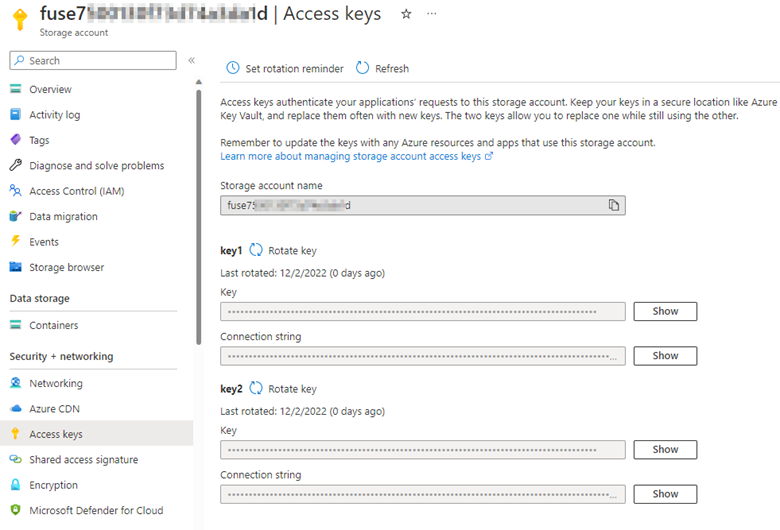
Go to the AKS cluster, select Configuration > Secrets, and then search for and access the associated secret.
Select Show (the eye icon) and compare the values of the storage account name and associated key with the values in step 1.
Before you select Show, the values of the storage account name and associated key are encoded into base64 strings. After you select Show, the values are decoded.
If you don't have access to the AKS cluster in the Azure portal, perform step 2 at the kubectl level:
Get the YAML file of the Kubernetes secret, and then run the following command to get the values of the storage account name and the key from the output:
kubectl get secret <secret-name> -n <secret-namespace> -o <yaml-file-name>Use the
echocommand to decode the values of the storage account name and the key and compare them with the values at the storage account level.Here's an example of decoding the storage account name:
echo -n '<storage account name>' | base64 --decode ;echo
Solution: Adjust the Kubernetes secret and re-create the pods
If the value of the storage account name or key in the Kubernetes secret doesn't match the value in Access keys in the storage account, adjust the Kubernetes secret at the Kubernetes secret level by running the following command:
kubectl edit secret <secret-name> -n <secret-namespace>
The value of the storage account name or the key added in the Kubernetes secret configuration should be a base64 encoded value. To get the encoded value, use the echo command.
Here's an example of encoding the storage account name:
echo -n '<storage account name>'| base64 | tr -d '\n' ; echo
For more information, see Managing Secrets using kubectl.
After the Kubernetes secret azure-storage-account-<storage-account-name>-secret has the correct values, re-create the pods. Otherwise, those pods will continue to use the old values that aren't valid anymore.
Cause 2: AKS's VNET and subnet aren't allowed for the storage account
If the storage account's network is limited to selected networks, but the VNET and subnet of the AKS cluster aren't added to the selected networks, the mounting operation will fail.
Solution: Allow AKS's VNET and subnet for the storage account
Identify the node that hosts the faulty pod by running the following command:
kubectl get pod <pod-name> -n <namespace> -o wideCheck the node in the command output:
Go to the AKS cluster in the Azure portal, select Properties > Infrastructure resource group, access the virtual machine scale set (VMSS) associated with the node, and then check the Virtual network/subnet to identify the VNET and subnet.

Access the storage account in the Azure portal, and then select Networking. If Public network access is set to Enabled from selected virtual networks or Disabled, and the connectivity isn't through a private endpoint, check if the VNET and subnet of the AKS cluster are allowed under Firewalls and virtual networks.
If the VNET and subnet of the AKS cluster aren't added, select Add existing virtual network. On the Add networks page, type the VNET and subnet of the AKS cluster, and then select Add > Save.
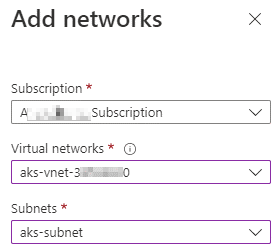
It may take a few moments for the changes to take effect. After the VNET and subnet are added, check if the pod status changes from ContainerCreating to Running.
BlobFuse error 3: Context deadline exceeded/An operation with the given Volume ID <…> already exists
Here are possible causes for this error:
- Cause 1: Network Security Group blocks traffic between AKS and the storage account
- Cause 2: Virtual Appliance blocks traffic between AKS and the storage account
Initial troubleshooting for BlobFuse error 3
Azure Blob BlobFuse relies on port 443. Make sure that port 443 and/or the IP address of the storage account aren't blocked.
To check the IP address of the storage account, run a Domain Name System (DNS) command like nslookup, dig, or host. For example:
nslookup <storage-account-name>.blob.core.windows.net
To check if there's connectivity between the AKS cluster and the storage account, get inside the node or pod and run the following nc or telnet command:
nc -v -w 2 <storage-account-name>.blob.core.windows.net 443
telnet <storage-account-name>.blob.core.windows.net 443
Cause 1: Network Security Group blocks traffic between AKS and the storage account
Check the output of the nc or telnet command mentioned in the Initial troubleshooting for BlobFuse error 3 section. If a time-out is displayed, check the Network Security Group (NSG) and make sure that the IP address of the storage account isn't blocked.
To check if the NSG blocks the IP address of the storage account, follow these steps:
In the Azure portal, go to Network Watcher and select NSG diagnostic.
Fill in the fields by using the following values:
- Protocol: TCP
- Direction: Outbound
- Source type: IPv4 address/CIDR
- IPv4 address/CIDR: The IP address of an instance that's associated with the AKS node
- Destination IP address: The IP address of the storage account
- Destination port: 443 (if using BlobFuse) and 111/2048 (if using NFS)
Select the Check button and check the Traffic status.
The Traffic status can be Allowed or Denied. The Denied status means that the NSG is blocking the traffic between the AKS cluster and the storage account. If the status is Denied, the NSG name will be shown.
Solution: Allow connectivity between AKS and the storage account
To resolve this issue, make changes accordingly at the NSG level to allow the connectivity between the AKS cluster and the storage account on port 443.
Cause 2: Virtual Appliance blocks traffic between AKS and the storage account
If you're using a Virtual Appliance (usually a firewall) to control outbound traffic of the AKS cluster (for example, the Virtual Appliance has a route table applied at the AKS cluster's subnet, and the route table has routes that send traffic towards the Virtual Appliance), the Virtual Appliance may block traffic between the AKS cluster and the storage account.
To isolate the issue, add a route in the route table for the IP address of the storage account to send the traffic towards the Internet.
To confirm which route table controls the traffic of the AKS cluster, follow these steps:
- Go to the AKS cluster in the Azure portal and select Properties > Infrastructure resource group.
- Access the VMSS or a virtual machine (VM) in an availability set if you're using such a VM set type.
- Select Virtual network/subnet > Subnets and identify the subnet of the AKS cluster. On the right side, you'll see the route table.
To add a route in the route table, follow the steps in Create a route and fill in the following fields:
- Address prefix: <storage-account's-public-IP>/32
- Next hop type:Internet
This route will send all traffic between the AKS cluster and the storage account through the public internet.
After you add the route, test the connectivity by using the nc or telnet command and perform the mounting operation again.
Solution: Ensure Virtual Appliance allows traffic between AKS and the storage account
If the mounting operation succeeds, we recommend that you consult your networking team to make sure that the Virtual Appliance can allow traffic between the AKS cluster and the storage account on port 443.
NFS 3.0 error 1: Exit status 32. No such file or directory
Cause: Blob container doesn't exist
To check if the Blob container exists, follow these steps:
Search for Storage accounts in the Azure portal and access your storage account.
Select Containers under Data storage in the storage account and check if the associated PersistentVolume (PV) exists in Containers. To see the Persistent Volume (PV), check the Persistent Volume Claim (PVC) associated with the pod in the YAML file, and then check which PV is associated with that PVC.
Solution: Ensure the Blob container exists
To resolve this issue, make sure that the Blob container that's associated with the PV/PVC exists.
NFS 3.0 error 2: Exit status 32, access denied by server while mounting
Cause: AKS's VNET and subnet aren't allowed for the storage account
If the storage account's network is limited to selected networks, but the VNET and subnet of the AKS cluster aren't added to the selected networks, the mounting operation will fail.
Solution: Allow AKS's VNET and subnet for the storage account
Identify the node that hosts the faulty pod by running the following command:
kubectl get pod <pod-name> -n <namespace> -o wideCheck the node in the command output:
Go to the AKS cluster in the Azure portal, select Properties > Infrastructure resource group, access the VMSS associated with the node, and then check the Virtual network/subnet to identify the VNET and subnet.

Access the storage account in the Azure portal, and then select Networking. If Public network access is set to Enabled from selected virtual networks or Disabled, and the connectivity isn't through a private endpoint, check if the VNET and subnet of the AKS cluster are allowed under Firewalls and virtual networks.
If the VNET and subnet of the AKS cluster aren't added, select Add existing virtual network. On the Add networks page, type the VNET and subnet of the AKS cluster, and then select Add > Save.

It may take a few moments for the changes to take effect. After the VNET and subnet are added, check if the pod status changes from ContainerCreating to Running.
NFS 3.0 error 3: context deadline exceeded / An operation with the given Volume ID <…> already exists
Here are possible causes for this error:
- Cause 1: Network Security Group blocks traffic between AKS and the storage account
- Cause 2: Virtual Appliance blocks traffic between AKS and the storage account
Initial troubleshooting for NFS 3.0 error 3
Azure Blob NFS 3.0 relies on ports 111 and 2049. Make sure that ports 111 and 2049 and/or the IP address of the storage account aren't blocked.
To check the IP address of the storage account, run a Domain Name System (DNS) command like nslookup, dig, or host. For example:
nslookup <storage-account-name>.blob.core.windows.net
To check if there's connectivity between the AKS cluster and the storage account, get inside the node or pod and run the following nc or telnet command:
nc -v -w 2 <storage-account-name>.blob.core.windows.net 111
nc -v -w 2 <storage-account-name>.blob.core.windows.net 2049
telnet <storage-account-name>.blob.core.windows.net 111
telnet <storage-account-name>.blob.core.windows.net 2049
Cause 1: Network Security Group blocks traffic between AKS and the storage account
Check the output of the nc or telnet command mentioned in the Initial troubleshooting for NFS 3.0 error 3 section. If a time-out is displayed, check the Network Security Group (NSG) and make sure that the IP address of the storage account isn't blocked.
To check if the NSG blocks the IP address of the storage account, follow these steps:
In the Azure portal, go to Network Watcher and select NSG diagnostic.
Fill in the fields by using the following values:
- Protocol: TCP
- Direction: Outbound
- Source type: IPv4 address/CIDR
- IPv4 address/CIDR: The IP address of an instance that's associated with the AKS node
- Destination IP address: The IP address of the storage account
- Destination port: 111 then 2048
Select the Check button and check the Traffic status.
The Traffic status can be Allowed or Denied. The Denied status means that the NSG is blocking the traffic between the AKS cluster and the storage account. If the status is Denied, the NSG name will be shown.
Solution: Allow connectivity between AKS and the storage account
To resolve this issue, make changes accordingly at the NSG level to allow the connectivity between the AKS cluster and the storage account on port 111/2048.
Cause 2: Virtual Appliance blocks traffic between AKS and the storage account
If you're using a Virtual Appliance (usually a firewall) to control outbound traffic of the AKS cluster (for example, the Virtual Appliance has a route table applied at the AKS cluster's subnet, and the route table has routes that send traffic towards the Virtual Appliance), the Virtual Appliance may block traffic between the AKS cluster and the storage account.
To isolate the issue, add a route in the route table for the IP address of the storage account to send the traffic towards the Internet.
To confirm which route table controls the traffic of the AKS cluster, follow these steps:
Go to the AKS cluster in the Azure portal and select Properties > Infrastructure resource group.
Access the virtual machine scale set (VMSS) or a VM in an availability set if you're using such a VM set type.
Select Virtual network/subnet > Subnets and identify the subnet of the AKS cluster. On the right side, you'll see the route table.
To add a route in the route table, follow the steps in Create a route and fill in the following fields:
- Address prefix: <storage-account's-public-IP>/32
- Next hop type: Internet
This route will send all traffic between the AKS cluster and the storage account through the public internet.
After you add the route, test the connectivity by using the nc or telnet command and perform the mounting operation again.
Solution: Ensure Virtual Appliance allows traffic between AKS and the storage account
If the mounting operation succeeds, we recommend that you consult your networking team to make sure that the Virtual Appliance can allow traffic between the AKS cluster and the storage account on ports 111 and 2049.
Contact us for help
If you have questions or need help, create a support request, or ask Azure community support. You can also submit product feedback to Azure feedback community.

